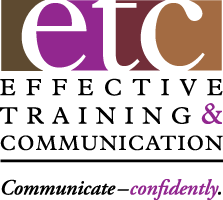(This month, we conclude our series of harnessing delivery skill best practices to mask Presentation Anxiety (PA) symptoms with the first of a two parts on gestures. What you do – and don’t do – with your hands can project confidence, credibility and competence – or not. So, let’s Hand It to Your Audience!)
We’ll start with a brief summary of Gesturing ‘Worst Practices’. It should be an interesting and mildly amusing trip, unless it hits too close to home and sounds like I’m talking about you. Next month, we’ll conclude with the Best Practice skills you can add to your Workplace Presenter Tool Kits and also help mask your PA. To begin …
A Physiology Primer
- That excess nervous energy your level of PA produces finds a warm and happy place to hide in your hands. That’s why nervous presenters often get the shakes. Trembling or fidgety hands or fingers are telltale signs of nervousness.
- The eyes of the audience are usually drawn to movement. When they are moving, the audience is compelled to look at them. If your hands are sending out a non-verbal message of ‘I’m nervous’, the audience can’t help but notice.
- Gestures can add visual value and punch to your message … or detract from it. Presenters with ineffective or distracting gestures don’t consciously plan them that way. They result from unconscious bad habits combined with that surging nervous energy that isn’t channeled more productively.
Worst Practices
That all said, here’s what you shouldn’t do with your hands:
- Not gesturing at all – humans generally gesture when they talk. Just watch a casual stand up conversation from a bit of a distance. Since presenting is talking, not gesturing looks odd and unnatural. The longer you go without some kind of gesture, the more conspicuous and distracting it becomes.
- Gesturing too much – the opposite extreme can also distract and annoy your audience. Such a distraction gets in the way of your message and quickly erodes your image of credibility.
- Overdoing the same gesture – even if the gesture itself is not done too much, using the same one all the time can really impact your audience. That same point, jab or chop can dominate their attention to the point that they begin counting them. Remember that professor in college who used the same ‘signature’ gesture over and over again … and the daily lottery some enterprising student ran to see who guessed the correct number of times?
- Fidgety movements – an entire family of unproductive hand or finger movements that add nothing to your message or image and only project nervousness, lack of confidence and credibility.
- Putting your hands together – they’re like ‘vel’ and ‘cro’. Once you put them together, you can’t get them apart. While this may make you feel more calm and comfortable, it doesn’t project power or confidence. And it may look like you’re praying for help or about to break into ‘Itsy Bitsy Spider …’
- Counting on your fingers – really? So trite and corny. Your audience doesn’t need you to be that obtuse. They can still get it when you use a more subtle transition from point #1 to point #2 than holding up two fingers.
- Hands behind your back – this action renders these natural visual aids powerless and looks like you’re hiding something. You are.
- Hands together in front/‘fig leaf’ position – remember that the eyes of your audience are drawn to your hands and movement. Is that where you want them to look? I didn’t think so.
- Both hands in your pockets – often an unconscious action to remove the fidgety hand movements from sight. Unfortunately, it looks exactly like that. If you continue the fidgets, it makes your pockets look like you brought your pet hamster with you to the presentation. Or, you start jingling the change in your pocket, which they can hear.
- One hand in your pocket – while projecting a more relaxed and casual image, you just lost one half of your visual aids. So, a little goes a long way.
If these Gesturing Worst Practices sounded too much like you, ask yourself why you do those things. If you’re not really happy with your answer, your audience won’t be either. So, tune in next month when we shift from Worst to Best and add some new or better skills to Hand it to Your Audience.
